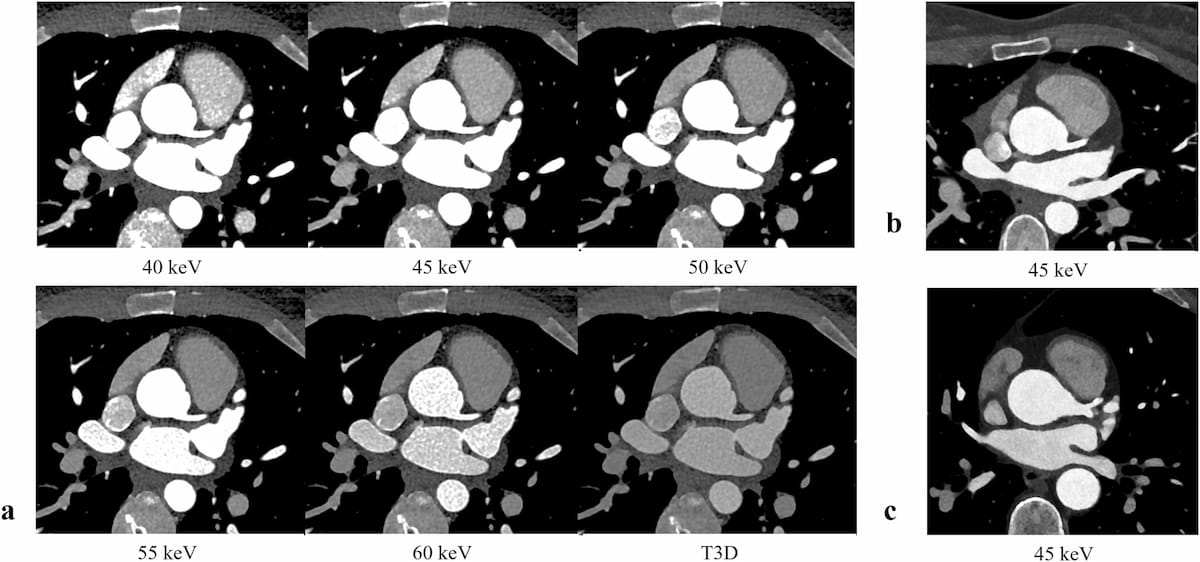Emerging Concepts with ICM Reduction and Photon Counting for Coronary CT Angiography
Emerging research suggests that achieving an optimal virtual monoenergetic image (VMI) energy level with photon-counting computed tomography (CT) may allow up to a 40 percent reduction of contrast media dosing for coronary CT angiography.
What is the optimal virtual monoenergetic image (VMI) energy level to facilitate contrast media (CM) reduction while maintaining high image quality for coronary computed tomography angiography (CCTA) with photon-counting detector CT (PCD-CT)?
Researchers recently sought the answer to that question in a retrospective study of 100 patients who had CCTA with PCD-CT. For the study, recently published in Academic Radiology, the authors assessed the optimal VMI energy level based on image quality in an initial group of 35 patients, and proceeded to examine the impact of 20 percent and 40 percent CM reductions, respectively, in group two (35 patients) and group three (30 patients).
The CM dosing ranged from 72 to 85.2 mL at a flow rate of 5 mL/s for group one; from 57.6 to 69.1 mL at a flow rate of 4 mL/s in group two; and between 43.2 and 51.6 mL at a flow rate of 3.2 mL/s in group three, according to the study.
The researchers found that 45 keV provided the best balance of objective quality image measures (ranging from vascular attenuation to contrast-to-noise ratio (CNR)) and subjective image quality measures (including subjective image contrast and subjective noise) in group one.
Here one can see axial virtual monoenergetic images (VMIs) at different energy levels in patients who had CCTA with PCD-CT. (Images courtesy of Academic Radiology.)

“In our study, 45keV was selected as the optimal energy level for CCTA, allowing a higher CM reduction. We hypothesize that the epicardial fat surrounding the coronary arteries improved the vessel delineation even with higher image noise, resulting in the selection of a lower value as the ideal energy level for VMI of CCTA,” wrote study co-author Kai Higashigaito, M.D., who is affiliated with Diagnostic and Interventional Radiology at University Hospital Zurich at the University of Zurich in Switzerland.
The researchers subsequently used 45 keV as the VMI level for groups two and three. In comparison to the mean vascular attenuation of 1110 Hounsfield units (HU) and mean CNR of 32 for group one, Higashigaito and colleagues noted a mean CNR of 25.8 and mean vascular attenuation of 890 HU with the 20 percent CM reduction in group two. For the 40 percent CM reduction in group three, the study authors said there was a mean vascular attenuation of 676 HU units and a mean CNR of 20.5.
Higashigaito and colleagues added that all CCTA examinations in groups one and two were rated as diagnostic. With the exception of severe motion artifacts for one patient, high diagnostic image quality was also achieved in group three, according to the study authors.
“Importantly, the mean vascular attenuation in group 3 was 676 HU and still way above the reported minimal vascular attenuation of 250 HU recommended by the Society of Cardiovascular Computed Tomography guidelines for the performance and acquisition of CCTA,” emphasized Higashigaito and colleagues.
The researchers added that the spectral data acquisition with PCD-CT may help enhance characterization of myocardial perfusion and assessment of extracellular volume fraction but emphasized that further research is necessary to determine optimal CM dosing for these applications.
Beyond the inherent limitations of a single-center study, the authors acknowledged using one type of CT scanner for the study, The researchers said it remained unclear whether the low-volume CM protocols demonstrated in the study would be applicable to obese patients due to a lack of these patients in the study cohort. The study authors also conceded a possible underestimation of image noise due to the application of only one level of iterative reconstruction, noting variations in image noise level with different reconstruction levels.
What is the Best Use of AI in CT Lung Cancer Screening?
April 18th 2025In comparison to radiologist assessment, the use of AI to pre-screen patients with low-dose CT lung cancer screening provided a 12 percent reduction in mean interpretation time with a slight increase in specificity and a slight decrease in the recall rate, according to new research.
Can CT-Based AI Radiomics Enhance Prediction of Recurrence-Free Survival for Non-Metastatic ccRCC?
April 14th 2025In comparison to a model based on clinicopathological risk factors, a CT radiomics-based machine learning model offered greater than a 10 percent higher AUC for predicting five-year recurrence-free survival in patients with non-metastatic clear cell renal cell carcinoma (ccRCC).
Could Lymph Node Distribution Patterns on CT Improve Staging for Colon Cancer?
April 11th 2025For patients with microsatellite instability-high colon cancer, distribution-based clinical lymph node staging (dCN) with computed tomography (CT) offered nearly double the accuracy rate of clinical lymph node staging in a recent study.